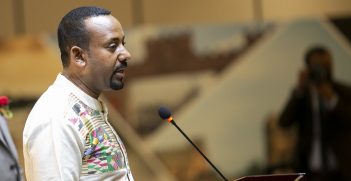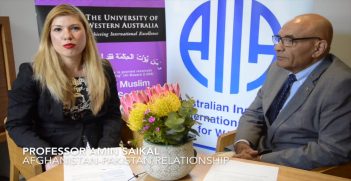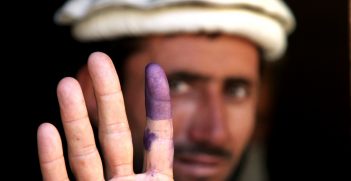ISIS: From State to Caliphate
The organisational identity of ISIS was never a unitary entity. Rather, it comprised binary—and often conflicting—themes: State and Caliphate.
Essential to ISIS’ global projection was the propagation of an organisational identity with which recruits could identify and develop their personal ideas, perceptions, and narratives. The unprecedented establishment of a domestic “Islamic State” formed the epicentre of this identity and the foundation of the group’s claim to legitimate rule. It was also the primary reference point from which the broader concepts, ideas, and symbols of ISIS propaganda drew (and continue to draw) their meaning.
Indeed, even during its time as Al Qaeda in Iraq (AQI), ISIS wrestled internally between its competing local and international components. While themes of State generally corresponded to the “local” of tangible grievances and objectives on the ground—as reminiscent of the platform of AQI—themes of Caliphate extended to an internationalised narrative invoking abstract ideological notions of community and service.
The title “State” itself is an artefact of the organisation’s early rebranding from AQI to the Islamic State of Iraq (ISI) in October 2006 in order to appeal to the grievances of local Sunni Iraqi communities. As ISI, the group demonstrated extensive organisational resistance to the international aspirations of its foreign leadership. Indeed, even after the group’s nominal merger with the Syria-based Al Qaeda affiliate Jabhat al Nusra to form ISIS in April 2013, the group’s projected identity was primarily intended to justify its assertion to legitimate representation of, and rule over, the Sunni Muslim resistance to both the Syrian and Iraqi Shia governments. Within this narrative, the survival and prosperity of the domestic State entity itself played a symbolic function in demonstrating the viability and necessity of Sunni resistance.
ISIS’ recruitment media strategy before the declaration of the Caliphate was to deploy “proper media propaganda concerning the situation of our regions [i.e.] the degree of security, justice (by Sharia) … in order to motivate crowds … to fly to the regions which we manage.” The Islamic State News for example, contained articles extensively describing ISIS’ state-building efforts in May and June 2014. These included such headlines as “Implementing the Hudud” — literally boundaries or limits, generally understood in a legal context — “Trade Flourishes under the Islamic State,” and “Fresh Produce Injects Life into Halab Market.” These articles were, however, liberally interspersed with graphic images of executions by hanging, shooting, and beheading and visceral reports and photography of the Istishhadiyyun (suicide bombers) and their operations. In doing so, ISIS rendered the survival and wellbeing of State inseparable from violence and death, and its early media even glorified this connection.
Although understandable to mobilise a community facing great uncertainty, as was ISI’s objective, ISIS’ projection of such a narrative endured, particularly after the declaration of the community-focused Caliphate. Indeed, editions of Dabiq — Islamic State News’ successor after the declaration of the Caliphate — continued to feature articles eerily similar to those in The Islamic State News during the initial 19-month period of the Caliphate. For example, “The Law of Allah or the Laws of Men” goes to great lengths to describe and graphically depict the symbolic efforts of ISIS’ justice institutions to enforce Sharia law, including the removal of shirki (pagan) idols, destruction of contraband, and visceral implementation of justice, including execution and amputation of limbs.
It may be reasonable to attribute the endemic violence associated with “State” in ISIS’ organisational identity to particularities of the group’s early history. However, the speed of ISIS’ transition from decentralised terror organisation to governing state entity blurred the lines between the stages of “vexation and exhaustion” and “the management of savagery.” This never entirely allowed the group to depict the latter’s institutions and practices of legitimation as distinct to the coercion and brutality it exercised in pursuit of the former. Thus, so long as ISIS projected an organisational identity dominated by the themes of State, while some recruits may not have joined ISIS because of its violence, they had to necessarily then join in spite of it.
Caliphate and “the power of establishment”
The declaration of the Caliphate afforded ISIS the opportunity to bloodlessly develop and colonise a new identity entirely removed from the violence of its past. The group’s nascent preference was to present its narrative in terms of Caliphate (or community) themes, and from mid-2015, ISIS’ consolidation of a community-centred “caliphate” identity began in earnest.
Although researchers disagree on what “Caliphate” per se definitively entails, a strong commonality between the definitions proffered is the notion of a united Umma, even if not in a strictly geographical sense. ISIS propaganda supports such an understanding, presenting the Caliphate as the spiritual homeland of Islam, and the entity through which the group might “unite the Umma [under] one calling, one banner, one leader.”
One might understand this shift through Crooke’s analysis of ISIS as a “neo-Ikhwani rejectionist protest”: that in presenting its metanarrative of resistance through themes of community, ISIS essentially reframed that resistance as transcending violence. In other words, the Caliphate was no longer simply “a sustainable alternative lifestyle” to the West, but rather a living refutation of it. Thus, recruits did not necessarily have to have joined ISIS to advance its jihad through violence, their simple existence in, and contribution to, the Caliphate community was adequate.
Messaging within this theme thus reinforces conceptions and ideas of the Caliphate as a place where “Muslims are re-empowered” and “people belong.” The nominal appeal of the Caliphate alone held great symbolic value in legitimising the ISIS cause. Indeed, the sheer profundity of the Caliphate’s revival, even to Muslims with moderate ideologies, was a “mobilising cause in the minds of many.” The sharp spike in recruitment in the weeks following the Caliphate’s revival would seem to support this assessment. However, such recruitment rapidly decreased in the weeks following the Caliphate’s declaration, suggesting that the appeal of the Caliphate label alone was not sustainable for recruitment.
Following the declaration of the Caliphate, ISIS began publication of acts justifying its Salafi credentials in earnest. It particularly emphasised the destruction of shirk (polytheistic/pagan artefacts) and the enduring heritage of nationalism. In a video entitled “No Respite,” for example, the narrator glorifies ISIS’ mujahidin as “the soldiers who stomped the idols of nationalism, demolished the shirki symbols of Palmyra and Ninawa and destroyed the Sykes-Picot borders.”
These deeply symbolic acts sought to establish a broad ideological congruency between ISIS itself and emotionally charged interpretations of a true or authentic Islamic State. In this context, relatively meaningless acts took on immense spiritual significance and were manufactured and presented to appeal to particular ideological interpretations of reality. The destruction of the Sykes-Picot line, for example, while in practice simply the bulldozing of a few outlying border posts, spoke extensively to themes of unity and reinforced the Caliphate’s credentials of uniting a part of the Umma by destroying the divisions of nationalism.
Technological coding and “non-violent” themes
ISIS was able to streamline its propaganda by both content and media format such that its audience did not simultaneously encounter material from its two seemingly paradoxical identities—the violent “Islamic State” and the community-focused “Caliphate”—where the content of the former might undermine that of the latter. In other words, the group applied principles of market segmentation to offer a “user-friendly,” community-focused story of resistance to its more considered—and likely more educated—audience in publications such as Dabiq, yet simultaneously maintained production and dissemination of its more violent face for the violent, martial “footsoldier” types. It thus afforded recruits the pre-emptive opportunity to self-select the ISIS “story” most appropriate to their stage of recruitment, interests, and motivations to both maximise the scope of recruitment and minimise the rate of attrition.
ISIS’ monopoly on the means of violence and coercion, however, remained fundamentally at odds with the organic community entity it sought to realise. Thus, themes of State persisted within ISIS’ platform such that the group never managed to entirely consolidate upon an identity based on the theme of Caliphate. Indeed, the enduring presence and production of violent recruitment material by the group outside its broadly published print media suggests that the Caliphate façade was largely superficial, a construction intended to mediate the group’s endemically violent ideology through nominal appeals to historical memory and peaceful community.
A number of western government organisations sought to leverage this enduring tension as a promising target for counter-narrative measures. The US Center for Strategic Counterterrorism Communications (USCSCC), now the Global Engagement Center, for example, developed a number of videos splicing content together from ISIS’ duelling themes into the one broadcast. Such videos, essentially parodies of the content they draw from, reveal the artificially idyllic, non-violent portrayals of life under ISIS jihad to be deadly superficial.
Publication of such videos under the pretence of their being genuine propaganda was intended to complicate and potentially stall a budding recruit’s advancement along the recruitment process. Although potentially politically problematic and not guaranteed to be effective by any means, these videos forced an additional obstacle into the process of recruitment attrition and likely prevented at least a few suggestible audience members from further recruitment.
ISIS’ early expansion constitutes a qualitatively new step in the development of international terrorism. In less than two years, and despite almost universal condemnation, the group inspired tens of thousands of eager recruits to travel from across the globe to join its ranks. In this regard, ISIS enduring legacy will most likely be its redefinition of the concept of jihad: where its predecessors had projected images of decentralised guerrilla campaigns, ISIS translated its narrative of resistance into themes and narratives that spoke to the personal experiences and aspirations of potential recruits otherwise uninterested in ascetic religious extremism.
Nicolas Johnston is a Visiting Fellow at the University of New South Wales, Sydney. He received a Masters in Strategy and Security from the Australian Defence Force Academy (UNSW Canberra) and a BA in Political Science and International Comparative Studies from Duke University.
This is an edited extract from Johnston’s article in the Australian Journal of International Affairs titled “Selling terror: a multidimensional analysis of the Islamic State’s recruitment propaganda.” It is republished with permission.





